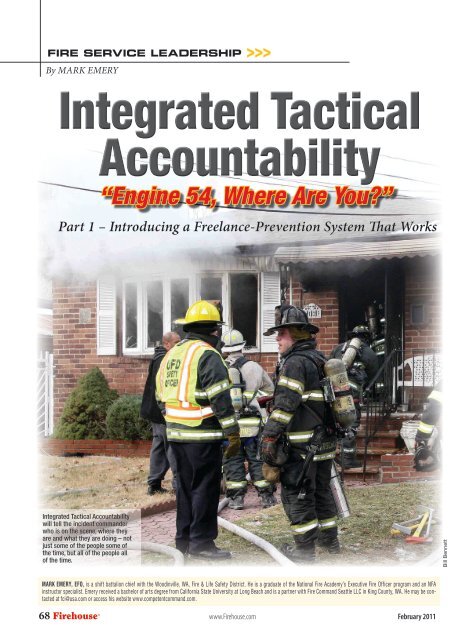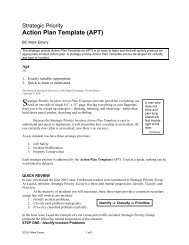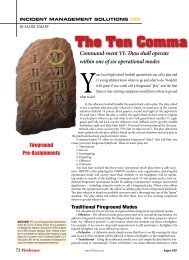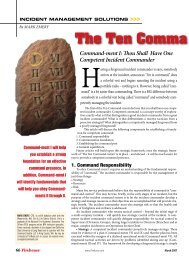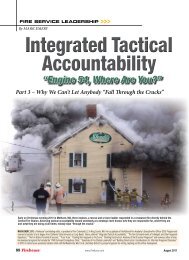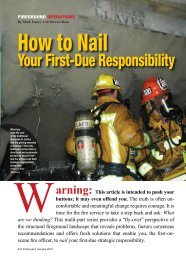ITAC Part-One - IMS Alliance
ITAC Part-One - IMS Alliance
ITAC Part-One - IMS Alliance
Create successful ePaper yourself
Turn your PDF publications into a flip-book with our unique Google optimized e-Paper software.
FIRE SERVICE LEADERSHIP >>><br />
By MARK EMERY<br />
Integrated Tactical<br />
Accountability<br />
“Engine 54, Where Are You?”<br />
<strong>Part</strong> 1 – Introducing a Freelance-Prevention System That Works<br />
Integrated Tactical Accountability<br />
will tell the incident commander<br />
who is on the scene, where they<br />
are and what they are doing – not<br />
just some of the people some of<br />
the time, but all of the people all<br />
of the time.<br />
Bill Bennett<br />
MARK EMERY, EFO, is a shift battalion chief with the Woodinville, WA, Fire & Life Safety District. He is a graduate of the National Fire Academy’s Executive Fire Officer program and an NFA<br />
instructor specialist. Emery received a bachelor of arts degree from California State University at Long Beach and is a partner with Fire Command Seattle LLC in King County, WA. He may be contacted<br />
at fci@usa.com or access his website www.competentcommand.com.<br />
68 Firehouse ® www.Firehouse.com February 2011
FIRE SERVICE LEADERSHIP<br />
Let’s get right to the point: If your implementation of the National Incident Management System (N<strong>IMS</strong>) Incident<br />
Command System (ICS) does not help you achieve and maintain tactical accountability, your implementation<br />
“system” is flawed and incomplete.<br />
You may remember the TV sitcom<br />
“Car 54, Where Are You?” which aired<br />
from 1961 to 1963 and later in reruns.<br />
The story line centered on the comical<br />
exploits of NYPD officers Gunther Toody<br />
and Francis Muldoon and their assigned<br />
cruiser, Car 54. Nobody in the fictitious<br />
53rd Precinct ever seemed to know where<br />
Toody and Muldoon were or what they<br />
were doing. The lack of Car 54 accountability<br />
made for some good laughs.<br />
The contemporary fire service has<br />
had a variety of personnel accountability<br />
systems in place for many years. Each of<br />
these systems can tell you who is at an incident;<br />
few accountability systems can tell<br />
you where each firefighter is at any given<br />
moment. Integrated Tactical Accountability<br />
will tell you who is there, where they<br />
are and what they are doing – not just<br />
some of the people some of the time, but<br />
all of the people all of the time. Integrated<br />
Tactical Accountability implementation<br />
means that freelancing can be prevented<br />
and thus should no longer be tolerated.<br />
Nobody will have to ask, “Engine 54,<br />
where are you?”<br />
Putting It to Work<br />
Tactical accountability can be<br />
achieved without batteries, without software<br />
and without expensive gee-whiz<br />
gadgets, and it will work at 3 o’clock in<br />
the morning. Achieving and maintaining<br />
tactical accountability is quick and easy<br />
and dovetails perfectly with the tenets of<br />
N<strong>IMS</strong> ICS and NFPA 1561. In fact, the<br />
Integrated Tactical Accountability system<br />
is the only implementation system in<br />
North America that offers how to meet<br />
or exceed all of the performance requirements<br />
identified by NFPA 1561, Standard<br />
on Emergency Services Incident Management<br />
System (2008 edition).<br />
To declare that your fire department<br />
has adopted and uses N<strong>IMS</strong> to manage an<br />
incident is not entirely true. N<strong>IMS</strong> may<br />
provide a familiar ICS framework for<br />
managing an incident (what’s old is new<br />
again), but N<strong>IMS</strong> fails to provide implementation<br />
guidance. Example: While it’s<br />
nice to know that a division is defined as<br />
geographic and a group is defined as functional,<br />
exactly how are you supposed to<br />
“supervise” a division or group during a<br />
multi-alarm fire? Shouldn’t a division be<br />
doing something functional within its<br />
geographic area of responsibility? Likewise,<br />
shouldn’t a group be executing its<br />
function someplace geographic? If they<br />
are both functional and geographic,<br />
what’s the true difference? (We will explore<br />
this question in a future article.)<br />
How, and in what form, do group<br />
supervisors receive and supervise their<br />
pieces of the overall incident action plan?<br />
How do division supervisors achieve and<br />
maintain tactical accountability? When<br />
the incident commander or a branch director<br />
asks for a status report, what do<br />
the division or group supervisors report?<br />
These questions probe well beyond basic<br />
geographic and functional distinctions.<br />
N<strong>IMS</strong> won’t help implement the ICS<br />
any more than the NFPA 1901 committee<br />
will submit a bid to build your next fire<br />
engine. N<strong>IMS</strong> was designed for what attorney<br />
and risk-management guru Gordon<br />
Graham refers to as “discretionary<br />
time” incidents. Discretionary means you<br />
have time to schedule a planning meeting<br />
for the next operational period. You don’t<br />
The Challenge<br />
The purpose of this three-part series is to help you eliminate freelancing by achieving and maintaining tactical accountability.<br />
PART ONE WILL:<br />
1. Establish why tactical accountability is important.<br />
2. Identify National Fire Protection Association (NFPA) standards that “require” that you achieve and maintain<br />
tactical accountability.<br />
3. Introduce important distinctions between personnel accountability and tactical accountability.<br />
4. Identify who is responsible for personnel accountability.<br />
5. Identify who is responsible for tactical accountability.<br />
PART TWO WILL:<br />
1. Describe how to quickly achieve tactical accountability (using familiar strategic tools).<br />
2. Describe how to maintain tactical accountability throughout the course of an incident.<br />
3. Illustrate how to establish a “thread” that strategically connects the command post with a firefighter operating a<br />
nozzle within the hazard area.<br />
PART THREE WILL:<br />
1. Introduce the three levels of fireground freelancing.<br />
2. Describe how to eliminate geographic freelancing.<br />
3. Describe how to eliminate functional freelancing.<br />
4. Clarify the real difference between a division and a group.<br />
5. Introduce strategic tools for controlling the ebb and flow of incident resources.<br />
February 2011 www.Firehouse.com Firehouse ® 69
FIRE SERVICE LEADERSHIP >>><br />
have the luxury of discretionary time<br />
when you are the first on-scene fire officer<br />
at a 3-o’clock-in-the-morning, multifamily<br />
building fire. The operational period<br />
is in your face.<br />
Nobody is going to fill out ICS 201<br />
and 203 forms in the front yard at a house<br />
fire, schedule a meeting and circulate<br />
copies of the plan to arriving companies.<br />
(Doing so would be trying to hammer<br />
a discretionary square peg into a nondiscretionary<br />
round hole.) ICS planning<br />
forms are designed for long-term incidents<br />
that offer discretionary time. Integrated<br />
Tactical Accountability provides<br />
a structured and systematic process for<br />
the implementation of N<strong>IMS</strong> ICS and<br />
NFPA 1561 during in-your-face, nondiscretionary<br />
time incidents – the kind of<br />
incidents that you respond to every day.<br />
Standards and Mandates<br />
Standards and mandates (N<strong>IMS</strong> is<br />
a federal mandate) provide guidance on<br />
what we should do, but they do not hint<br />
at how we should comply. Compliance<br />
and implementation is up to the “authority<br />
having jurisdiction” (AHJ). To address<br />
the spirit and intent of a particular standard<br />
or mandate is up to your organization<br />
or region. Consider the following<br />
citations from the 2008 edition of NFPA<br />
1561, Standard on Emergency Services<br />
Incident Management System:<br />
4.5.2 The system shall maintain accountability<br />
for the location and status<br />
condition of each organizational element<br />
at the scene of the incident.<br />
5.3.10 The incident commander shall<br />
maintain an awareness of the location and<br />
function of all companies or units at the<br />
scene of the incident.<br />
5.8.9.1 All supervisory personnel shall<br />
maintain a constant awareness of the position<br />
and function of all responders assigned<br />
to operate under their supervision.<br />
5.8.9.2 This awareness shall serve as<br />
the basic means of accountability that<br />
shall be required for operational safety.<br />
Note the words I emphasized: location…condition…function…position…basic.<br />
What these NFPA citations require as a<br />
“basic means of accountability” is that the<br />
incident commander and division/group<br />
supervisors shall maintain an awareness<br />
of the location/position and function of all<br />
companies, units and responders (personnel).<br />
Also notice that this basic means of<br />
accountability shall be required for operational<br />
safety. NFPA 1561 ventures well beyond<br />
mere personnel tracking. However,<br />
as mentioned previously, NFPA does not<br />
provide a hint at how to make sure this<br />
happens. The term I coined for maintaining<br />
this location and function awareness<br />
is “tactical accountability.” The structured<br />
and systematic process which assures<br />
seamless compliance is called Integrated<br />
Tactical Accountability.<br />
“Accountability” Defined<br />
There is a significant difference between<br />
personnel accountability and tactical<br />
accountability. In general, “accountability”<br />
is defined as a process for tracking<br />
personnel during an incident. According<br />
to NFPA 1561, personnel accountability<br />
is a system that “readily identifies both<br />
the location and function of all members<br />
operating at an incident scene.” (There<br />
are those pesky words again: location and<br />
function.) “Location” means more than<br />
knowing that there are eight companies<br />
on the fireground and that there are a<br />
70 Firehouse ® www.Firehouse.com February 2011
FIRE SERVICE LEADERSHIP<br />
bunch of firefighters somewhere in the<br />
building; location means you know from<br />
what side each team entered the building<br />
and on what floor each team is working.<br />
Tactical accountability means that you<br />
also know what each team is doing and<br />
why. Again, if freelancing is tolerated, it is<br />
impossible to achieve and maintain tactical<br />
accountability.<br />
To ensure that the tenets of NFPA 1561<br />
– and N<strong>IMS</strong> ICS – are addressed, two levels<br />
of accountability are needed: personnel<br />
and tactical. The only way this can be<br />
achieved and maintained is by aggressive<br />
span-of-control management. More than<br />
anything else, the ICS is a span-of-control,<br />
resource-management system. Consider<br />
the following NFPA 1561 citations:<br />
5.1.6 The command structure for each<br />
incident shall maintain an effective supervisory<br />
span of control at each level of the<br />
organization.<br />
A.5.1.6 A span of control of responders<br />
between three and seven is considered<br />
desirable most cases.<br />
5.3.12 The incident commander shall<br />
initiate an accountability and inventory<br />
worksheet at the beginning of operations<br />
and shall maintain that system throughout<br />
operations.<br />
Note the conflict within these citations.<br />
For example, a span of control of three to<br />
seven is considered ideal, yet the incident<br />
commander is supposed to initiate – and<br />
maintain – an accountability and inventory<br />
worksheet throughout the incident. This<br />
is silly; imagine an incident commander<br />
fiddling with this worksheet throughout<br />
a multi-alarm incident. How can the incident<br />
commander maintain this inventory<br />
worksheet of all resources and maintain the<br />
ideal span of control at the command post?<br />
Not only does this violate fundamental ICS<br />
span of control, it doesn’t work. This is one<br />
reason why many fire departments choose<br />
to dump resource tracking responsibility on<br />
somebody else, this person is often called<br />
an “accountability officer.” Here’s a hint:<br />
The presence of an “accountability officer”<br />
is a reliable indicator that, first, the fire department<br />
has not integrated accountability<br />
into the Incident Command System, and,<br />
second, it does not know how to achieve<br />
and maintain tactical accountability (or, in<br />
many cases, is not aware that it should).<br />
The good news is that there has always<br />
been an ICS position with unlimited<br />
span of control and whose responsibility<br />
it is to track resources: the staging area<br />
manager. It’s no surprise that NFPA 1561<br />
advises that resources should check in<br />
with the staging area manager. Considering<br />
that advice, guess which ICS position<br />
Indicate 139 on Reader Service Card<br />
fire departments should assign to assist<br />
the incident commander with resource<br />
tracking? The bad news is that resource<br />
tracking is not tactical accountability.<br />
Staging provides non-hazard-area<br />
personnel accountability; the staging area<br />
manager can quickly tell you where Engine<br />
54 was sent (not where it is) and what<br />
February 2011 www.Firehouse.com Firehouse ® 71
FIRE SERVICE LEADERSHIP


